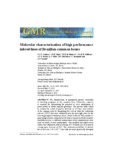Use este identificador para citar ou linkar para este item:
http://www.alice.cnptia.embrapa.br/alice/handle/doc/953582Registro completo de metadados
| Campo DC | Valor | Idioma |
|---|---|---|
| dc.contributor.author | CARDOSO, P. C. B. | pt_BR |
| dc.contributor.author | VEIGA, M. M. | pt_BR |
| dc.contributor.author | MENEZES, I. P. P. de | pt_BR |
| dc.contributor.author | VALDISSER, P. A. M. R. | pt_BR |
| dc.contributor.author | BORBA, T. C. O. | pt_BR |
| dc.contributor.author | MELO, L. C. | pt_BR |
| dc.contributor.author | DEL PELOSO, M. J. | pt_BR |
| dc.contributor.author | BRONDANI, C. | pt_BR |
| dc.contributor.author | VIANELLO, R. P. | pt_BR |
| dc.date.accessioned | 2013-12-13T22:21:13Z | - |
| dc.date.available | 2013-12-13T22:21:13Z | - |
| dc.date.created | 2013-03-20 | pt_BR |
| dc.date.issued | 2013 | pt_BR |
| dc.identifier.citation | Genetics and Molecular Research, v. 12, n. 4, p. 5467-5484, Feb. 2013. | pt_BR |
| dc.identifier.issn | 1676-5680 | pt_BR |
| dc.identifier.uri | http://www.alice.cnptia.embrapa.br/alice/handle/doc/953582 | pt_BR |
| dc.description | The identification of germplasm genetic variability in breeding programs of the common bean (Phaseolus vulgaris) is essential for determining the potential of each combination of parent plants to obtain superior genotypes. The present study aimed to estimated the extent of genetic diversity in 172 lineages and cultivars of the common bean by integrating five tests of value for cultivation and use (VCU) that were conducted over the last eight years by the breeding program of Embrapa Arroz e Feijão in Brazil. Nine multilocus genotyping systems composed of 36 fluorescent microsatellite markers distributed across 11 different chromosomes of the common bean were used, of which 24 were polymorphic in all trials. One hundred and eighty-seven alleles were identified, with an average of 7.79 alleles per locus and an average gene diversity of 0.65. The combined probability of identity for all loci was 1.32 x 10(-16). Lineages that are more genetically divergent between the selection cycles were identified, allowing the breeding program to develop a crossbreed between elite genotypes with a low degree of genetic relatedness. HE values ranged from 0.31 to 0.63, with a large reduction in the genetic base over successive selection cycles. The test showed a significant degree of differentiation (FST = 0.159). Private alleles (26%) were identified and can be directly incorporated into the gene pool of cultivated germplasm, thereby contributing effectively to the expansion of genetic diversity in this bean-breeding program. | pt_BR |
| dc.language.iso | eng | eng |
| dc.rights | openAccess | eng |
| dc.subject | Melhoramento genético | pt_BR |
| dc.title | Molecular characterization of high performance inbred lines of Brazilian common beans. | pt_BR |
| dc.type | Artigo de periódico | pt_BR |
| dc.date.updated | 2013-12-13T22:21:13Z | pt_BR |
| dc.subject.thesagro | Feijão | pt_BR |
| dc.subject.thesagro | Phaseolus vulgaris | pt_BR |
| dc.subject.thesagro | Variação genética | pt_BR |
| dc.subject.nalthesaurus | Inbred lines | pt_BR |
| dc.subject.nalthesaurus | Genetic lines | pt_BR |
| riaa.ainfo.id | 953582 | pt_BR |
| riaa.ainfo.lastupdate | 2013-12-13 | pt_BR |
| dc.identifier.doi | http://dx.doi.org/10.4238/2013 | pt_BR |
| dc.contributor.institution | P. C. B. CARDOSO, UFG; M. M. VEIGA, UFG; I. P. P. DE MENEZES, UNIVERSIDADE ESTADUAL DE SANTA CRUZ, ILHÉUS-BA; PAULA ARIELLE M RIBEIRO VALDISSER, CNPAF; TEREZA CRISTINA DE OLIVEIRA BORBA, CNPAF; LEONARDO CUNHA MELO, CNPAF; MARIA JOSE DEL PELOSO, CNPAF; CLAUDIO BRONDANI, CNPAF; ROSANA PEREIRA VIANELLO, CNPAF. | pt_BR |
| Aparece nas coleções: | Artigo em periódico indexado (CNPAF)  | |
Arquivos associados a este item:
| Arquivo | Descrição | Tamanho | Formato | |
|---|---|---|---|---|
| gmr.pdf | 554,98 kB | Adobe PDF |  Visualizar/Abrir |









